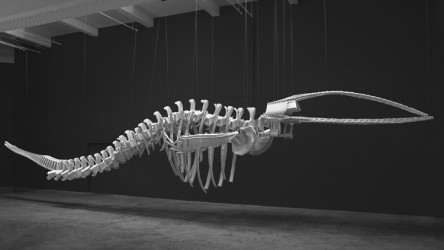Article Origin
Volume
Issue
Year
Photo Caption: Brian Jungen’s Cetology, 2002, made of plastic chairs. Collection of the Vancouver Art Gallery, Purchased with the financial support of the Canada Council for the Arts Acquisition Assistance Program and the Vancouver Art Gallery Acquisition Fund (VAG 2003.8 a-z)
Aboriginal art work featured at AGA
The Art Gallery of Alberta is showcasing the work of contemporary Canadian artist Brian Jungen. The next exhibition features three sculptured works by Jungen, including Carapace, which was first created in 2009 for an exhibition at the FRAC des Pays de la Loire (France) and completely reconfigured for an exhibition at the Smithsonian National Museum of the American Indian (Washington, D.C.) later that year. Jungen’s mother is Dane-Zaa First Nation. The way the exhibits are grouped (with other features included between Jungen and the Haida Art) is significant. “The grouping of exhibitions is intended to celebrate art in Canda but also to address its complex history, particularly the intersections and, often polemical, relationship of modernism to Aboriginal culture,” said Catherine Crowston, AGA deputy director/chief curator.
Violence against Aboriginal women discussed
Members of the House of Commons Standing Committee on the Status of Women were in Edmonton on Jan. 21 as part of its study of violence against Aboriginal women. In March 2010, the Standing Committee on the Status of Women passed a motion to undertake a study on violence against Aboriginal Women. In the five-hour session in downtown Edmonton, committee members heard from representatives of the RCMP, Edmonton Police Service, family services organizations, universities, and Aboriginal women’s organizations. The committee is holding hearings and visiting organizations involved in efforts to reduce and prevent violence against Aboriginal women across the country.
Annual homeless memorial remembers
The 6th Annual Homeless Memorial remembered Edmontonians who died without a home. At least 57 homeless people passed away from a wide range of causes in 2010, an increase from the 46 people who passed away in 2009. The memorial, held Jan. 22 in the drop-in at Boyle Street Community Services, was planned and hosted by the Edmonton Coalition on Housing and Homelessness Society. The memorial included prayers and music to celebrate the lives of those lost as a direct or indirect result of being homeless. For some of those who died, this memorial is the only one in which they are remembered. The memorial also served to support family and friends grieving their lost loved ones; to gather as a community to consider and support those living without adequate housing; to increase the awareness of the tragic effects of homelessness; and to celebrate life.
Police commissioner former CFO for Kehewin First Nation
Keli Tamaklo, one of two police commissioners appointed late November 2010 by Edmonton’s city council is the former chief financial officer for Whitefish Lake First Nation. The Edmonton Journal is reporting that Tamalko served as CFO for more than 12 years before the First Nation went into court-ordered receivership. Edmonton’s police commission oversees a $300-million budget, monitors discipline within the force, and will play a pivotal role in selecting the city’s next police chief. Tamalko’s position with the city is a volunteer one, which qualifies him for a stipend of $450-$750 per month. Tamaklo’s connections to local African communities and his experience with First Nations made him standout among the list of candidates, said consultant Elena Charlebois, who managed the selection of the candidates.
Housing, support available
Since September 2010, Boyle Street Community Services has made housing available and provided support for Aboriginal people moving to Edmonton for either work or education purposes. Rooms are available in two newly renovated five-bedroom homes. Boyle Street set up the common living space to rent for Aboriginal people moving into the city, who will be working or attending school. Each resident has a private bedroom with lock which is fully furnished including television and internet. Kitchen gear and common area living are also provided. Housing is not for families. Length of stay is not limited. There is also a dedicated housing support worker, who can provide information about services available, provide transition help for school or work, and provide access to community Elders.
Compiled by Shari Narine
- 2011 views

